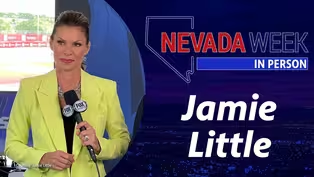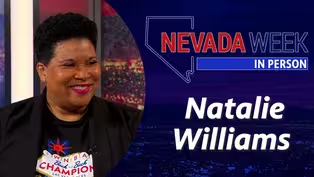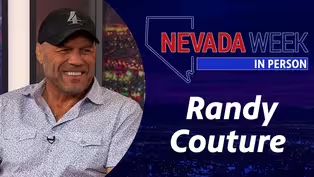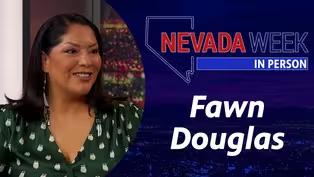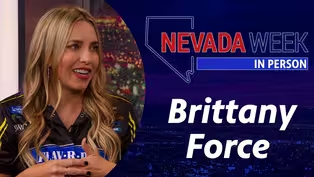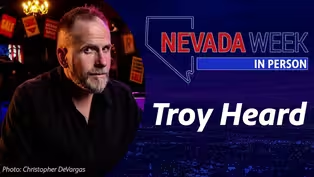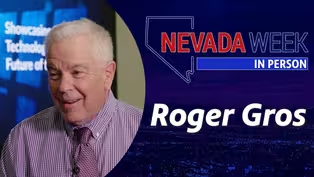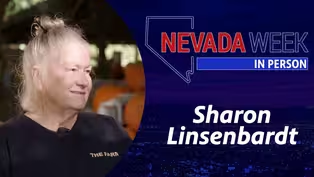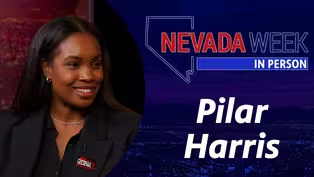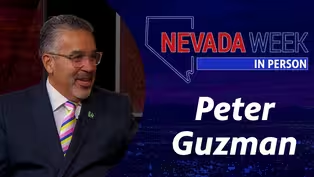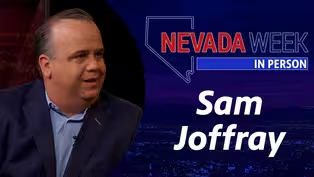
Nevada Week In Person | Vicki Richardson
Season 1 Episode 58 | 14mVideo has Closed Captions
One-on-one interview with director of Left of Center Gallery Vicki Richardson.
One-on-one interview with director of Left of Center Gallery Vicki Richardson.
Problems playing video? | Closed Captioning Feedback
Problems playing video? | Closed Captioning Feedback
Nevada Week In Person is a local public television program presented by Vegas PBS

Nevada Week In Person | Vicki Richardson
Season 1 Episode 58 | 14mVideo has Closed Captions
One-on-one interview with director of Left of Center Gallery Vicki Richardson.
Problems playing video? | Closed Captioning Feedback
How to Watch Nevada Week In Person
Nevada Week In Person is available to stream on pbs.org and the free PBS App, available on iPhone, Apple TV, Android TV, Android smartphones, Amazon Fire TV, Amazon Fire Tablet, Roku, Samsung Smart TV, and Vizio.
Providing Support for PBS.org
Learn Moreabout PBS online sponsorshipMore from This Collection
Nevada Week In Person goes beyond the roundtable discussion of Nevada Week with guests for a more casual conversation about their personal passions, new projects and compelling stories that are overlooked in the flurry of the news cycle.
Nevada Week In Person | Jamie Little
Video has Closed Captions
One-on-one interview with Jamie Little, NASCAR Broadcaster (14m)
Nevada Week In Person | Chet Buchanan
Video has Closed Captions
One-on-one interview with Chet Buchanan,Host & Creator, 98.5 KLUC’s The Chet Buchanan Show (14m)
Nevada Week In Person | Natalie Williams
Video has Closed Captions
One-on-one interview with Natalie Williams, General Manager, Las Vegas Aces (14m)
Nevada Week In Person | Randy Couture
Video has Closed Captions
One-on-one interview with Randy Couture, UFC Hall of Famer & U.S. Army Veteran (14m)
Nevada Week In Person | Fawn Douglas
Video has Closed Captions
One-on-one interview with Fawn Douglas, Artist and Activist, Nuwu Art (14m)
Nevada Week In Person | Brittany Force
Video has Closed Captions
One-on-one interview with Brittany Force, World Champion Drag Racer (14m)
Nevada Week In Person | Troy Heard
Video has Closed Captions
One-on-one interview with Troy Heard, Artistic Director, Majestic Repertory Theatre (14m)
Nevada Week In Person | Roger Gros
Video has Closed Captions
One-on-one interview with Roger Gros, Publisher, Global Gaming Business Magazine (14m)
Video has Closed Captions
One-on-one interview with Sharon Linsenbardt, Owner, Las Vegas Farm and Barn Buddies Rescu (14m)
Nevada Week In Person | Pilar Harris
Video has Closed Captions
One-on-one interview with Pilar Harris (14m)
Nevada Week In Person | Peter Guzman
Video has Closed Captions
One-on-one interview with Latin Chamber of Commerce Nevada President & CEO Peter Guzman (14m)
Nevada Week In Person | Sam Joffray
Video has Closed Captions
One-on-one interview with Sam Joffray, President & CEO, Las Vegas Super Bowl LVII Host Com (14m)
Providing Support for PBS.org
Learn Moreabout PBS online sponsorshipAn artist, activist, teacher, and local business owner, Vicki Richardson, founder of Left of Center Art Gallery, is our guest this week on Nevada Week In Person .
♪♪♪ Support for Nevada Week In Person is provided by Senator William H. Hernstadt.
Welcome to Nevada Week In Person.
I'm Amber Renee Dixon coming to you from Left of Center Art Gallery in North Las Vegas, where education has long motivated the gallery's founder and director.
She's also played a big part in the public art you may have seen around town.
Vicki Richardson, thank you so much for joining Nevada Week In Person .
-Well, thank you.
-So before coming to Las Vegas, you've been in this North Las Vegas gallery about 30 years now.
But before coming here, you were in Delaware.
And I want to go back to when you were growing up and you were one of, I believe, a dozen African American students chosen to be integrated into what was a segregated school system.
What was life like back then for you?
-Well, at the time I was elementary school age, I had been in all Black school at that time, and I had all the influences that come from being educated in that way.
And when we were to integrate the schools, actually, what they did is they tried to siphon off the cream of the crop.
And so that was a big issue at that time.
-You were part of the cream of the crop?
-Well, they considered me.
[laughter] -But it was-- the Black schools were just, you know, just felt that that was wrong, you know, to take the, the highest group of the people and put them, you know, just take them out of their environment and everything they had been teaching us all along.
And when we went over to a different junior high, for going from elementary to junior high school, we were a curiosity, mostly.
And I think in some of the situations that we were in, the teachers didn't know exactly how to treat us, you know?
It was an experiment, the whole thing was an experiment.
And I think it sort of determined what I did later in life, because one of the things I did is prepare teachers for integration, because they were afraid.
They were-- it was a setting that was unfamiliar with them.
And so there's a certain sensitivity to it, and you didn't want them to put the new students coming in, in a box or feel like they had to work harder or do more or show up differently as they came into the classroom.
And I felt that in a lot of cases, some of the teachers' expectations were lower.
And so they didn't hold the student to the same standard because they didn't think that they could, you know, really reach the standards that they had already set for the other white students in the class.
-How did you go about taking in that information from them and not allowing it to infuriate you?
Or did you?
-No, I don't think I let it infuriate me.
Before that, in the late 60s, early 70s, I was infuriated about so many things.
-That's when you would consider yourself a civil rights activist?
-Yes, yes.
-In what form?
Did you protest, or did you educate?
-Well, I went to Fisk University in Nashville, Tennessee.
And I selected that university because it was the most active school as far as civil rights and nonviolent demonstrations and things like that.
And Martin Luther King was there all the time.
You had to take a class in order to be on the line, to walk on the line.
You actually had to take a class on not really showing a lot of emotion, not getting angry.
If someone burned you with a cigarette or someone spit on you or something like that, you were just not to react.
You were there for a purpose, and you had to keep that purpose uppermost in your mind while you were doing it, or else it could be dangerous.
-Did you meet Martin Luther King, Jr?
-I did not, I did not.
I did not meet him personally, but I've heard him speak; I've been in the audience where he has spoken.
-Talking about that, I guess, skill set that you learned, not reacting, not getting angry, and also talking about your choice to pick that school in Nashville because of its prevalence in being so active in protests, it reminds me just of your move here to Las Vegas.
You purposely picked Rancho High School.
-Definitely, yeah.
-And those characteristics of being kind of a teacher, I guess, not overreacting when a student may be misbehaving, why Rancho High School?
-Well, number one, my education was from University of Chicago.
And then University of Chicago, they sent us as causeways into the schools, where we had support of each other.
The English teacher, the science teacher, the art teacher, we all worked on curriculum together.
We all worked on knowing who our students were, how to get the best out of our students.
And the classes that we took were in what was then called inner city education.
So when I came here and interviewed, I told them I would prefer to be in an inner city school.
They told me, We don't have any inner city schools.
It's like "inner city" had a bad name or something.
And I'm thinking, I have to research this for myself.
And so they told me that the closest thing, these were other teachers and people that I talked to, would be Rancho High School as an inner city school, because it had more diversity there than most of the schools did here at the time.
-Always art that you've taught; correct?
-Yes.
-So how can art especially be critical in an inner city school, for example?
-Oh, my goodness.
Number one, the people.
The students are so interesting in their backgrounds and in their way of dealing with life and society.
And they have a lot to bring to it.
They have a lot of stories to tell, and they have a lot of talent.
So I think the key is just sort of getting the best out of them, directing their talent, giving them new mediums to work with, and really just being positive with them, you know?
I used to think that when I came into the classroom, I was a cheerleader.
Okay, let's get going!
You know?
You have to really set the mood for them and make them feel comfortable in the environment they're in because some of them have had bad, very bad classroom experiences.
-I want to fast-forward to the gallery that we're sitting in.
-Mm-hmm.
-Why did you choose to open, and what was the need at the time about 30 years ago?
And why North Las Vegas?
-I would say that the artists that I met when I first came here, we were exhibiting and putting work into different, mostly different competitive, you know, things that were going on in the city to get your art in, in the libraries and things like that.
And sometimes we would get in, sometimes we wouldn't get in.
But if we went to the independent galleries, they would say something like, Well, we really like your art, but we really don't think it would sell here.
And give me, you know, different things like that.
So I'm thinking, Okay, if we can't get our art into these galleries, we just have to create our own.
So that's what happened.
And so I started identifying, trying to identify different artists that were in the area.
And I found out there were quite a few, actually.
They just weren't showing their art.
And so that's when I said that I would go and visit them, go personally to their homes, Where's your art?
Somebody told me you were taking art at UNLV.
Or, you know, They'd seen you exhibit it for some people that were out of prison that did beautiful art.
And I would say, Where is your art?
And it would be in a garage behind something.
They'd have to pull things out to show it to me, or under the bed and just hidden in all kinds of spaces.
I mean, it wasn't given the respect it should have been given.
And so we started saying, Okay, we've got to do more of this; we've got to go-- we have to do more.
And I got involved with another person who was retired military, he was an artist in the military; Sylvester Collier; and Harold Bradford, who had come here to work for YesCo.
And the three of them were really supportive of me wanting to find art, to show art, and to eventually have a gallery space.
-The significance of the room that we're sitting in, the Museum Collection of African Art, what does this mean to you?
-It means everything to me.
It's the dream that I had.
It's the passion that I have to make it worthy and to make it an educational tool here in the community, because I think it talks to us about a different culture.
And I think that, basically, we understand each other better when we understand each other's culture and respect each other's culture.
-What are you most proud about of this gallery?
-I think the fact that we're here to help each other, you know?
We're here to help each other grow, and it has become an incubator for young and up-and-coming artists.
And we do everything from teaching them how to put their portfolios together to how to do a resume, anything we can to make it a little easier for them to transition into this competitive world of art.
And we also have an, an open house every Saturday, because to me, it's sort of like the artists are always working.
You know, it's mysterious and private, and then you just see these things; but you can actually see the artists making art.
And that's a very important part of what we want to do.
We don't want to distance the artists from the community.
We want the artists to engage the community.
-And you talk about the competitive world of art.
You've experienced that firsthand.
How do you help fund this gallery?
You're also a local business owner.
-Well, the gallery started as a profit, for-profit gallery.
And a lot of galleries went under.
Everybody kept telling me that, Everything you do, you give away free, you know, so you're really a nonprofit, because we weren't in it, you know, just to be making big bucks.
We had, you know, a social reason that we wanted to do this gallery.
And so it's nonprofit, but I was also trying to find some way to make it sustainable.
And that's when I reached out, when I just saw it in the newspaper that they were looking for some minority businesses at the airport.
And I went through the whole process, which was almost a year, to get in, trying to explain to them why I felt I was-- I needed this to do what we're doing here.
-And you now own three Auntie Anne's pretzel shops?
-Yes, I do.
I have three Auntie Anne's, one in the Premium Outlet North and two in the airport, and they give back into the gallery, especially for our youth classes and things like that.
They make donations to the gallery.
-Vicki Richardson, thank you for joining Nevada Week In Person.
And for more Nevada Week In Person, go to Vegaspbs.org/nevadaweek.

- News and Public Affairs

Top journalists deliver compelling original analysis of the hour's headlines.

- News and Public Affairs

FRONTLINE is investigative journalism that questions, explains and changes our world.












Support for PBS provided by:
Nevada Week In Person is a local public television program presented by Vegas PBS
